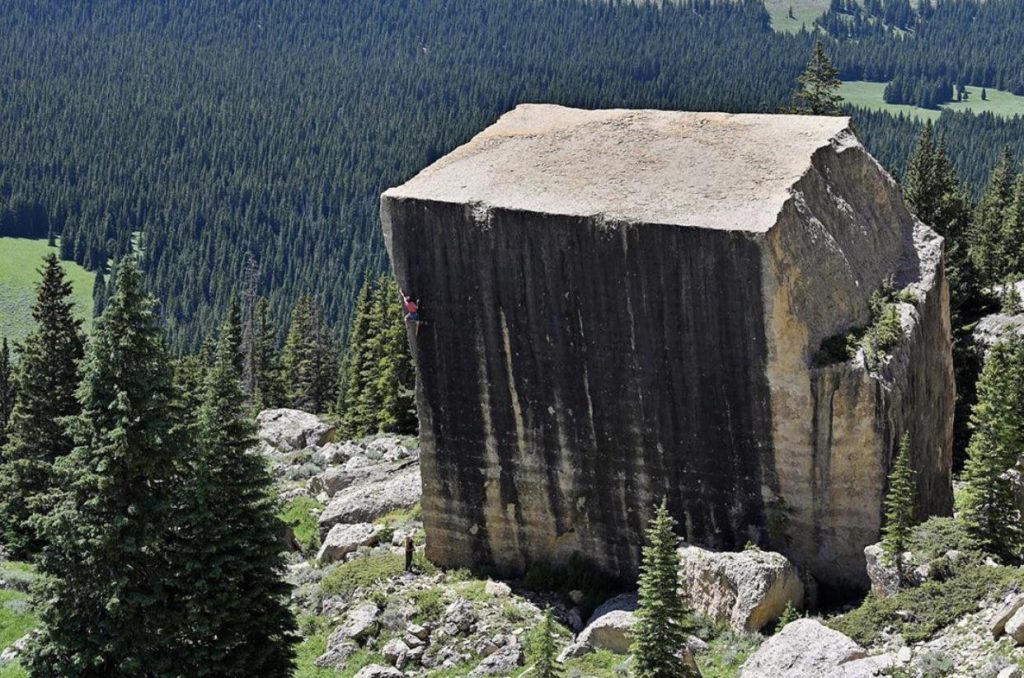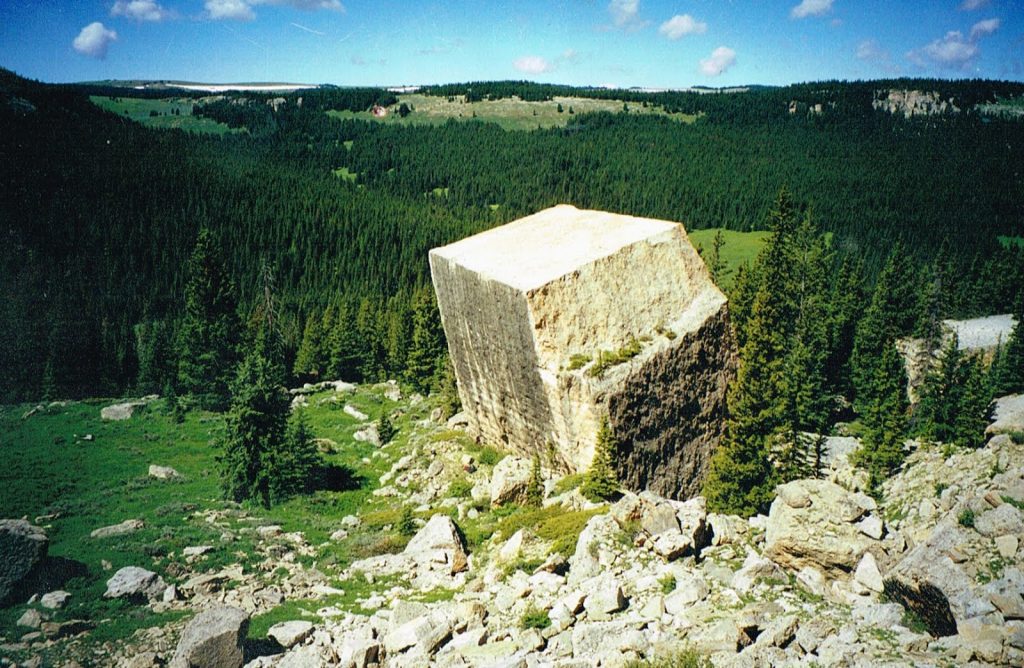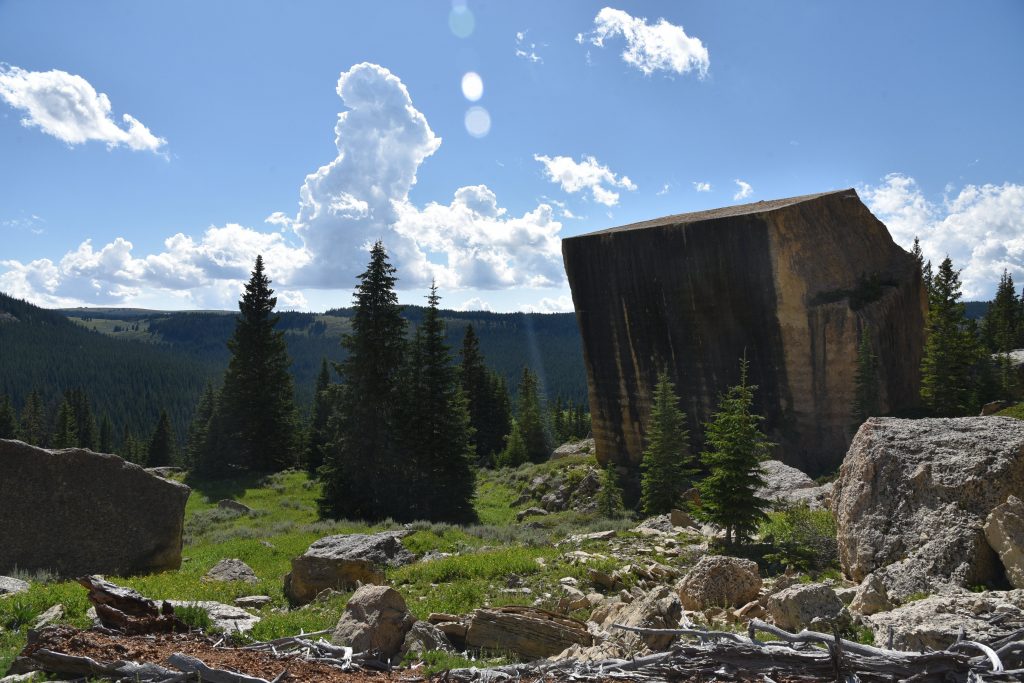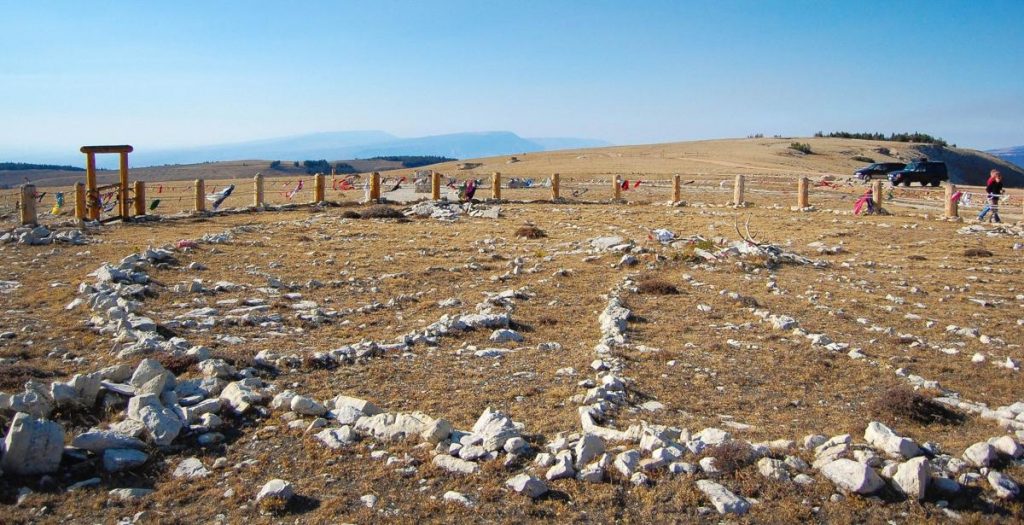THE "FALLING BLOCK" IN WYOMING

The Enigmatic Falling Block of Wyoming: Nature or Man-Made?
Nestled amidst the striking vistas of Wyoming, a peculiar geological feature has captured the imagination of many—a massive block of rock poised in a precarious position, seemingly defying the laws of gravity. Known colloquially as the “Falling Block,” this strange formation has sparked widespread debate among scientists and enthusiasts alike, raising questions about its origin and the possibility of human involvement in its creation. It’s located in the Eastern part of the Bighorn, in the plateau northwest of the Dihedrals Wall. The descent to this site is described being very steep and “undeniably nasty”. It is therefore a place scarcely visited by people.
The most interesting feature of this stone block is the “scoop marks” all around it. While it’s possible that they occurred naturally, it is worthy to note that the process of shaping and cutting stone in a way that resulted in this “scooped” appearance was also used in the megalithic sites of South America, Egypt (at the Aswan Quarry), China (at the Longyou Caves, where the caves were shaped using this exact technique), and it can be seen in Stonehenge, too.
Nature’s Oddity
At first glance, the Falling Block appears to be a simple rock formation like many others scattered throughout the vast landscapes of Wyoming. However, upon closer examination, its unique characteristics become apparent. The block, resembling a giant stone suspended over a slope, showcases an unnatural symmetry that raises eyebrows. The edges of the rock are remarkably smooth, contrasting sharply with the rough, uneven surfaces typical of most natural formations. This has led many to ponder whether this is the result of natural erosion or a product of human craftsmanship.
Even for those who maintain the natural hypothesis this is a weird structure for two reasons: it is the only stone block in a very wide area, and it really looks like it was artificially shaped. It is perfectly squared and leveled at the top, and it has the same marks of many other megalithic man made structures in the world.

Geological Wonders
Wyoming’s geology is a tapestry of history, shaped over millions of years by volcanic activity, glacial movements, and erosion. The Falling Block itself is thought to be a remnant of ancient sedimentary layers that have been exposed over time. The surrounding landscape is rich with fossils, minerals, and unique rock formations, making it a hotspot for geologists studying Earth’s history. However, what sets the Falling Block apart is its unusual placement and stability. While many rock formations are grounded firmly into the earth, this block seems to hover, challenging conventional understanding of balance in nature.
Human Influence: Theories Abound
Given its unique features and location, theories regarding the Falling Block’s origin abound. Some suggest it could be a man-made structure, possibly the remnants of an ancient civilization long lost to history. Proponents of this idea argue that the precision of the block’s angles and its stability imply deliberate placement or construction, possibly serving as a marker or monument.
Additionally, local legends and folklore often mingle with the scientific discussion. Some claim that Native American tribes revered the Falling Block as a sacred site, believing it held spiritual significance. This adds another layer to the mystery, suggesting that if it was indeed man-made, it could have been crafted for purposes beyond mere utility.
The Quest for Answers
While many scientists remain skeptical of the man-made theory, dismissing the block as a natural phenomenon, the allure of its enigma continues to captivate researchers and tourists alike. Geologists frequently conduct studies to understand the geological processes responsible for such formations, while archaeologists explore the surrounding areas for any signs of human history that might connect to the Falling Block.
Furthermore, advances in technology, such as 3D modeling and geological surveys, are facilitating deeper investigations into this curious structure. These studies may provide clearer insights and shed light on whether natural processes or human hands shaped this fascinating feature.

A Mystery Worth Exploring
Whether it is a remarkable anomaly born from geological forces or a relic of an ancient civilization is still up for debate. Regardless, it invites us to ponder our place in the world—where the past, present, and the unknown collide.
As more research unfolds, we may one day unlock the secrets held within this enigmatic structure. Until then, the Falling Block continues to be a symbol of mystery and a reminder of the timeless quest for knowledge that defines the human experience. Whether you’re a skeptic or a believer in its man-made origins, one truth remains: the Falling Block is a captivating marvel waiting to be unraveled, drawing adventure-seekers and history buffs to its rocky embrace in the heart of Wyoming.
The Medicine Wheel

Interestingly enough, Wyoming hosts other megalithic sites such as the “Medicine Wheel”, a stone circle similar to Stonehenge.
This ancient stone structure, often shrouded in mystery, serves not only as a remarkable archaeological site but also as a symbol of spiritual significance and community. Its intricate design and historical relevance make it a captivating destination for both visitors and researchers interested in the intersection of nature and cultural identity.
A Site of Spiritual Significance
The Medicine Wheel, also known as the “Bighorn Medicine Wheel,” is a circular arrangement of stones measuring approximately 80 feet in diameter, with a central hub and several radiating spokes that extend outward. While the exact date of its construction remains uncertain, many scholars believe it dates back over 1,000 years, making it a significant relic of Native American history. Tribes such as the Crow, Lakota, and Shoshone are thought to have utilized the site for various ceremonial and astronomical purposes.
The wheel’s design is rich with symbolism. The layout is thought to represent the four cardinal directions—North, South, East, and West—each associated with various spiritual meanings, elements, and colors. Many Native American cultures view these directions as sacred and integral to their cosmology. The Medicine Wheel serves as a reminder of the interconnectedness of life, nature, and spirituality, reflecting the values and beliefs of the indigenous people who built and used it.
Astronomical Alignments
One of the most intriguing aspects of the Medicine Wheel is its potential astronomical alignments. Researchers have found that certain stone alignments correspond with the rising and setting of the sun, moon, and stars during significant seasonal events, such as solstices and equinoxes. This suggests that the wheel may have been used as an astronomical observatory, allowing ancient peoples to track celestial movements, which held great significance for agricultural practices and spiritual rituals.
Visitors to the site can appreciate how the landscape and the stars can converge in a place of such profound cultural meaning. Watching the sunrise or sunset from the Medicine Wheel reveals a breathtaking spectacle, further deepening its allure.
